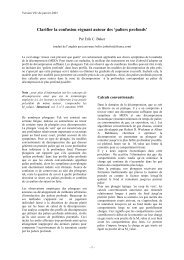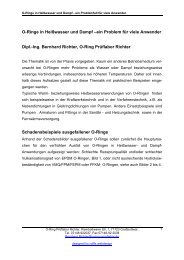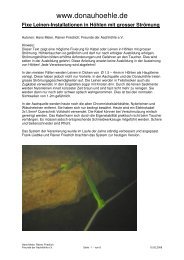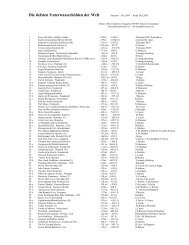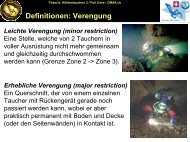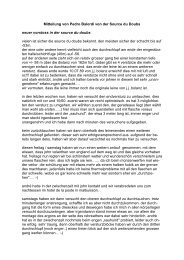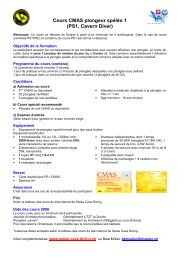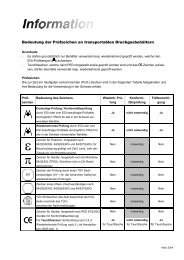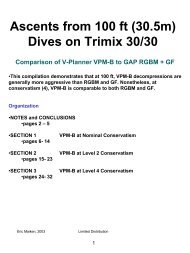cave diving and the nss - bei Swiss-Cave-Diving
cave diving and the nss - bei Swiss-Cave-Diving
cave diving and the nss - bei Swiss-Cave-Diving
You also want an ePaper? Increase the reach of your titles
YUMPU automatically turns print PDFs into web optimized ePapers that Google loves.
52 CAVE DIVING COMMUNICATIONS<br />
REELS AND LINE MARKERS 53<br />
When tying onto <strong>the</strong> new line, wrap <strong>the</strong> jump reel twice around <strong>the</strong><br />
new line, <strong>the</strong>n clip <strong>the</strong> reel onto <strong>the</strong> new line in <strong>the</strong> direction of<br />
travel. Again, this makes it easier to retrieve <strong>the</strong> temporary line<br />
<strong>and</strong> will let o<strong>the</strong>r teams know your plan.<br />
Conclusion<br />
The preceding presentation on <strong>the</strong> use of reels <strong>and</strong> line<br />
markers will, we believe, help to establish a consistent method of<br />
deploying this apparatus <strong>and</strong> make available to <strong>the</strong> <strong>cave</strong>-<strong>diving</strong><br />
community a consistent means of communication. With <strong>the</strong>se<br />
st<strong>and</strong>ardizations established, variations can be more readily identified<br />
<strong>and</strong> interpreted by <strong>cave</strong> divers in <strong>the</strong> field.<br />
Clo<strong>the</strong>spin added to a temporary-line connection<br />
Many <strong>cave</strong> divers like to add a clo<strong>the</strong>spin to <strong>the</strong> outbound<br />
side of any temporary line connection. This added clip provides<br />
an additional directional confirmation to <strong>the</strong> tie-off point. Should <strong>the</strong><br />
divers be forced to return through this connection in low visibility<br />
<strong>and</strong> ab<strong>and</strong>on <strong>the</strong> temporary reel for later pick up, no second<br />
guessing will be required at <strong>the</strong> intersection. O<strong>the</strong>r teams prefer<br />
that each team member mark <strong>the</strong> intersection with his own clip.<br />
Tying into <strong>the</strong> middle of a<br />
permanent line with a temporary line<br />
When tying into a permanent line with any kind of temporary line,<br />
it is recommended that <strong>the</strong> tie-in point avoid nearby placements,<br />
wraps, or tie-offs of <strong>the</strong> permanent line. Tying in a few inches to<br />
<strong>the</strong> right or left of placements, wraps, or tie-offs—depending on <strong>the</strong><br />
intended direction of travel—provides for clean line-to-line contact.<br />
Having one or more lines use <strong>the</strong> same tie-off fixture could cause<br />
unnecessary delay during a low-visibility exit.<br />
Jumping from <strong>the</strong> middle of one line to ano<strong>the</strong>r<br />
The procedure here is <strong>the</strong> same as with <strong>the</strong> gap reel except that<br />
a directional decision must be reinforced before <strong>the</strong> jump. A<br />
clo<strong>the</strong>spin or arrow should be installed on <strong>the</strong> outbound side of<br />
<strong>the</strong> jump. When <strong>the</strong> jump is made in a reasonably large, clean<br />
tunnel, a clo<strong>the</strong>spin is sufficient. If low visibility is expected on <strong>the</strong><br />
return trip, an arrow is preferable. If in doubt, install an arrow.




